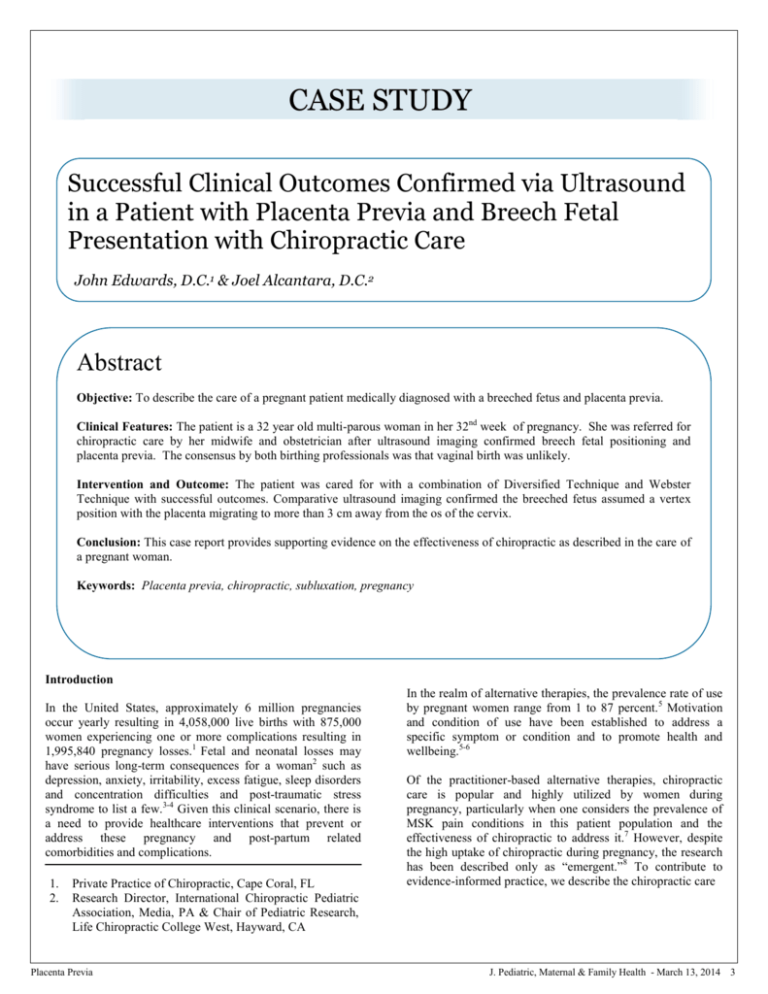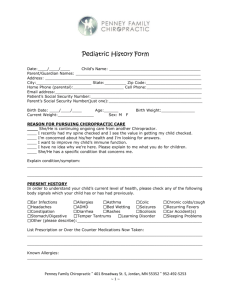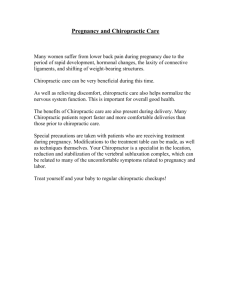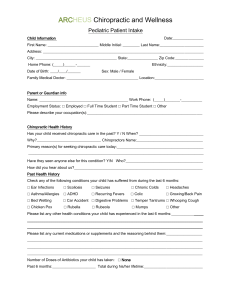case study - Mccoypress.net
advertisement

CASE STUDY Successful Clinical Outcomes Confirmed via Ultrasound in a Patient with Placenta Previa and Breech Fetal Presentation with Chiropractic Care John Edwards, D.C.1 & Joel Alcantara, D.C.2 Abstract Objective: To describe the care of a pregnant patient medically diagnosed with a breeched fetus and placenta previa. Clinical Features: The patient is a 32 year old multi-parous woman in her 32nd week of pregnancy. She was referred for chiropractic care by her midwife and obstetrician after ultrasound imaging confirmed breech fetal positioning and placenta previa. The consensus by both birthing professionals was that vaginal birth was unlikely. Intervention and Outcome: The patient was cared for with a combination of Diversified Technique and Webster Technique with successful outcomes. Comparative ultrasound imaging confirmed the breeched fetus assumed a vertex position with the placenta migrating to more than 3 cm away from the os of the cervix. Conclusion: This case report provides supporting evidence on the effectiveness of chiropractic as described in the care of a pregnant woman. Keywords: Placenta previa, chiropractic, subluxation, pregnancy Introduction In the United States, approximately 6 million pregnancies occur yearly resulting in 4,058,000 live births with 875,000 women experiencing one or more complications resulting in 1,995,840 pregnancy losses.1 Fetal and neonatal losses may have serious long-term consequences for a woman2 such as depression, anxiety, irritability, excess fatigue, sleep disorders and concentration difficulties and post-traumatic stress syndrome to list a few.3-4 Given this clinical scenario, there is a need to provide healthcare interventions that prevent or address these pregnancy and post-partum related comorbidities and complications. 1. 2. Private Practice of Chiropractic, Cape Coral, FL Research Director, International Chiropractic Pediatric Association, Media, PA & Chair of Pediatric Research, Life Chiropractic College West, Hayward, CA Placenta Previa In the realm of alternative therapies, the prevalence rate of use by pregnant women range from 1 to 87 percent.5 Motivation and condition of use have been established to address a specific symptom or condition and to promote health and wellbeing.5-6 Of the practitioner-based alternative therapies, chiropractic care is popular and highly utilized by women during pregnancy, particularly when one considers the prevalence of MSK pain conditions in this patient population and the effectiveness of chiropractic to address it.7 However, despite the high uptake of chiropractic during pregnancy, the research has been described only as “emergent.” 8 To contribute to evidence-informed practice, we describe the chiropractic care J. Pediatric, Maternal & Family Health - March 13, 2014 3 of a pregnant patient with placenta previa and breech fetal presentation with successful outcomes. Case Report times, and upon re-examination of the Webster analysis, both heels evenly approximated the ischial tuberosities. The patient was instructed to lay prone and low-force myofascial and trigger point releases were performed on both the left round ligament and right psoas muscle . History Outcomes A 32 year old multi-parous woman presented for chiropractic care in her 32nd week pregnancy. She was referred for chiropractic care by her midwife and obstetrician after ultrasound imaging confirmed both breech fetal positioning and placenta previa. There was a consensus by both birthing professionals that since the placenta was partially obstructing the cervical os, it would not be possible to attempt a vaginal birth. The patient had delivered her three previous children without complication or intervention at a local birthing center specializing in water birth. She suffered no significant trauma since her last delivery 3 years earlier, but had a history of 3-4 months of chiropractic care following a motor vehicle accident 4 years prior to her first pregnancy. Examination A systems review revealed mild asthma in the winter months and vital signs within normal ranges for pregnancy. A spinal alignment analysis was performed using the PostureScreen Mobile software (Trinity, FL, USA; 2011) for the iPhone 3G with data points selected on both eyes, mid lip, jugular notch, bilateral acromio-clavicular joints, ASIS, and mid talus on the frontal view and the external auditory meatus, the cervicothoracic spine junction, trochanter, mid-knee and lateral malleolus on the profile view. The patient’s alignment demonstrated a 0.40 0 left lateral head shift from the midline with a 2.50 tilt inferiorly to the left, a 0.520 left rib cage shift, and a 4.40 hip tilt inferiorly to the left (see Figure 1). From the profile (see Figure 2), the patient demonstrated a 1.27 inch head shift forward from the midline, a 1.17 inch shift backward of the shoulder, a 1.41” forward trochanter shift and a 0.53” forward knee shift. Cervical, thoracic, and lumbar ranges of motion (ROM) were within normal limits and both George’s Test for vertebrobasilar artery insufficiency and Kemp’s Test for lumbar and sacroiliac joint pain were negative. Static palpation revealed spasms on the left lateral aspect of C1 with restricted left lateral bending at the segment and a short right arm on the supine psoas tension test. Intervention The patient was instructed to lay prone on two specially prepared memory foam pillows to perform the prone exam, which revealed a positive right Webster sign for sacro-iliac involvement, with the left heel approximating the ischial tuberosity on flexion and the right remaining several inches away. After adjusting the sacrum prone three times utilizing a pelvic drop, the re-assessment of the Webster analysis showed both legs gave equal resistance to flexion, but neither would approximate the ischial tuberosities. The next lumbar segment above the sacrum was adjusted as a PR utilizing a Diversified drop-table technique repeated 3 4 J. Pediatric, Maternal & Family Health - March 13, 2014 The patient was attended a total of 9 visits over the course of three weeks and provided at-home exercises including pelvic tilts and mobilizations. She was also instructed to spend 10-15 minutes daily crawling on her hands and knees. Throughout the course of treatment there were inconsistent findings using the Webster sacral analysis. Of the 9 visits, 5 times the patient demonstrated a right resistant leg on 5 occasions and on the left 4 times. Three of those visits required a left-to-right diversified adjustment to the lowest lumbar segment to allow the heels to approximate the ischial tuberosities, and two of them required a right-to-left line of drive of that lowest segment. The psoas sign that appeared on the right at the initial examination changed to the left for the next three visits before re-testing normalized, and on four occasions the left round ligament was indicated as dysfunctional and on three occasions the right one was “tighter”, and twice they were both equally dysfunctional At the 5th visit the patient felt as if her baby had turned transverse, and she began to take the supplement Pulsitilla and spending time in her swimming pool for exercise and leisure. The patient reported on the 6th visit that she felt the baby move more when she ate or drank something cold than when she took the herbs. At the 8th visit the patient reported feeling the baby had moved low and to her right, and on the following visit she reported that on the two previous nights, she felt that her baby had moved up into her ribs and back down again. Following her 10th chiropractic visit, she was scheduled with her obstetrician for ultrasound imaging. The imaging confirmed her reports of fetal movements and that her baby had moved into the vertex position with the placenta migrating to more than 3 cm away from the os of the cervix. Both the obstetrician and midwife confirmed the results and the patient was “cleared” to deliver vaginally. A comparative spinal alignment examination demonstrated her head had shifted 0.130 left with a 3.30 clockwise tilt, a 0.130 counter-clockwise shoulder tilt, a 0.470 left shift of the ribcage and her left hip rotation had reduced to 2.00. Spinal alignment had improved closer to the midline for all of the markers in the coronal plane. Forward head carriage had reduced to 1.14”, shoulders had improved to 0.77” back, hips were shifted 0.74”, and knees were 0.34” forward. The patient attended 3 more chiropractic visits before her contractions began, and on visit 12, she reported her contractions had occurred regularly at 10 minutes apart. A final pre-natal spinal alignment examination, the findings were similar as previously described with a 0.440 left head shift and 3.40 left tilt, with no significant shifts or rotations in the shoulders or ribcage. The patient’s hip had shifted left 0.17” but the analysis did not Placenta Previa detect any pelvic rotation. The profile view had changed all markers forward of the plane line. The forward head carriage reduced to 0.45” and her shoulders had moved to 0.32” forward. Her trochanter was calculated to be 1.11” forward and the knees 0.37” relative to the midline. The patient delivered a healthy baby in the water at the birthing center without complication. Two weeks postpartum, she returned for 6 visits over a four-week time span, initially complaining of a focal sharp pain in the left abdomen which resolved after the first adjustment and psoas release. Subsequent visits addressed mild right sacroiliac joint pain which completely resolved after the fifth visit. A post-partum spinal analysis examination demonstrated a 2.80 left head tilt, a 0.530 left shoulder shift, and a 0.67” shift of the hips left from the midline. The patient’s head anterior carriage increased to 1.35” forward and shoulders shifted to 0.27” back, with an increase in the anterior displacement of the hips to 1.83” and the knees to 1.14” backward from the calculated center of gravity. Discussion There are many interesting and clinically relevant issues for discussion in the case report presented. In the interest of brevity, we will focus on three aspects of the case: the comanagement of the patient characterized as integrative medicine, patient’s breeched fetus and diagnosis of placenta previa. Medical plurism (i.e., the use of both conventional and alternative therapies) is well established. In the case report presented, the attending chiropractor has an established professional relationship and works closely with midwives and medical physicians situated within a birthing center. The patient attended chiropractic care on the advice of her obstetrician and midwife. Interestingly, referrals to alternative practitioners during pregnancy have been found to be more likely to be midwifeled than obstetrician-led and obstetricians appear more cautious and skeptical than midwives about CAM use for women in their care.9 To examine the health service utilization among pregnant women for both conventional and alternative therapy, Steele and colleagues10 surveyed 1835 women and found that the consultation with alternative practitioners only involved certain conditions such as neck pain and sciatica. Women consulted both CAM practitioners and conventional maternity health professionals (i.e., obstetricians, midwives and GPs) for back pain and gestational diabetes. Women who had more frequent visits to a midwife were more likely to have consulted with an acupuncturist or a doula than those visiting midwives less frequently for their pregnancy care. Steele and colleagues10 concluded that their study findings emphasize the need for a considered and collaborative approach to interactions between pregnant women, conventional maternity health providers and alternative practitioners to accommodate appropriate information transferral and coordinated maternity care. Placenta Previa Adams and colleagues11 performed an integrative review of the literature to determine the attitudes and behaviors of maternity care professionals towards alternative therapies during pregnancy. A total of 21 papers covering 19 studies were identified. Findings from these studies were extracted, grouped and examined according to three key themes: 'prevalence of practice, recommendation and referral', 'attitudes and views' and 'professionalism and professional identity'. The authors asserted that there is a need for greater respect and cooperation between conventional and alternative practitioners as well as communication between all maternity care practitioners and their patients about the use of alternative therapies. Münstedt and colleagues12 explored the clinical indications for using CAM in obstetrics. The authors sent out a questionnaire to delineate who provided the alternative therapy (i.e., midwife or physician). The authors found that alternative therapies were widely offered despite perceived lack of evidence of effectiveness or information on adverse consequences. Although obstetricians are responsible for patient care, decisions to provide alternative therapy were largely taken by midwives, and the midwives' belief in the methods' effectiveness as well as patient demand. There is a long history of collaboration between midwives and chiropractors in the care of pregnant women. In a survey of midwives, Mullin and colleagues13 found that midwives were aware that chiropractors worked with "birthing professionals" and attended to patients with both musculoskeletal and nonmusculoskeletal disorders. A vast majority indicated a positive personal and professional clinical experience with chiropractic and that chiropractic was safe for pregnant patients and children. Allaire and colleagues14, surveyed North Carolina midwives on the use of herbal and other CAM therapies and found that 53% of midwives would recommend chiropractic to their clients. Bayles15, in a survey on the use, recommendation, and referral of Texas midwives also reported that chiropractic was the most popular for the care of pregnancy-related MSK complaints. In most deliveries near term, the fetus presents by the head, with the best fit into the lower pelvis in the occipito-anterior position. For the patient presented, ultrasound imaging determined that her pregnancy was breeched. The most common fetal malpresentation; the buttocks, not the head, is at the lower pole of the uterus and is termed breech from the old English word brec—breeches or buttocks).16 Approximately 3% to 4% of all pregnancies reach term with the fetus in breech presentation.17-18 Before 28 weeks of gestation, approximately 25-30% of all fetuses will present as breech. At 34 weeks of gestation, 7-8% of babies are breech19 with 50% of these breeched fetuses turning by themselves to head down by 38 weeks.20 Frank breech is the most common type of presentation and occurs in about 60% of breech births.21 Single or double footling account for 35% of breech births and is a common presentation for pre-term fetuses. The remaining breech presentations involve complete breech presentations.19 J. Pediatric, Maternal & Family Health - March 13, 2014 5 A baby is more likely to turn from breech to head down if the mother has previously given birth. Perinatal morbidity and mortality with breech presentation have been estimated to be three times more likely when compared to fetuses with vertex presentation for vaginal delivery.22 Maternal complications include preterm gestation, abnormalities in amniotic fluid volume, uterine anomalies, placenta previa and multifetal gestations while examples of fetal complications include hydrocephalus, anencephaly, and other conditions that impair fetal movement.21 In terms of delivery, vaginal delivery babies presenting as breech is associated with increased neonatal mortality compared with Cesarean delivery while Cesarean delivery is associated with maternal morbidity compared with the vaginal delivery.23 As such, planned Caesareans is the choice of birthing. However, planned Caesarean section compared with planned vaginal birth reduced perinatal or neonatal death or serious neonatal morbidity for the singleton breech baby at term, at the expense of somewhat increased maternal morbidity. As a result of the pregnancy-related morbidities such as low back pain and risks involved with medical procedures for breech pregnancies, expectant mothers turn to alternative therapies for care.24 Of the various practitioner-based alternative therapies, chiropractic is popular for both pregnant and non-pregnant women.5, 25 Chiropractic Care In a practice-based research network, Alcantara and colleagues26 characterized the chiropractic care of pregnant women and found the use of the Webster Technique as very common and possibly reflects the uniqueness of this technique in the care of pregnant patients. The authors further commented that this observation may also indicate the need for expertise and specialization of this type of care. In a similar setting (i.e., PBRN), Alcantara et al.27 examined the effectiveness of the Webster technique based on a convenience sample of 81 pregnant women presenting for chiropractic care with fetal malposition and malpresentation. The investigators found that previous or concurrent care included external cephalic version, slant board, acupuncture, moxabustion, homeopathy and various forms of exercises. Based on 63 of the 81 subjects, the authors found that 70% of the subjects with abnormal fetal pregnancies reported a correction to the vertex position, indicating possible effectiveness of the Webster Technique in influencing positive outcomes. Before we commence further, we wish to emphasize in these discussions that the theoretical and clinical framework of the Webster Technique is not to “turn” the breeched fetus as in external cephalic version. Rather it is to address lumbopelvic subluxations to allow for a more optimal environment for the fetus with positive outcomes for the baby for a natural childbirth.28 In the case report presented, an examination of the impact of chiropractic adjustments on the patient’s prenatal spinal alignment suggests a reduction on the absolute difference of 6 J. Pediatric, Maternal & Family Health - March 13, 2014 the ribcage and hip shifts from midline, a reduction in pelvic rotation, and an improvement in the distance the head, shoulder, and knee were positioned anterior or posterior from midline. Furthermore, the patient was able to maintain the improvements in absolute difference between head and shoulder and shoulder and hip positioning in the sagittal plane after her delivery compared to her initial presentation. Based on the attending chiropractors in the care of pregnant women, he was of the clinical opinion that during pregnancy the body experiences a rapid change in the distribution of mass over a short time frame, so it’s reasonable to expect the postural righting systems to take some time to adapt. The postnatal postural examination findings partially support this presumption with the landmarks as described retreating further from the midline when compared to the examination immediately before delivery. However, the chiropractor was of the opinion that the postural examination also suggest that the chiropractic adjustments left some lasting impact on the patient’s postural alignment, considering head shift, rib cage shift, hip tilt, shoulder translation and the absolute differences between sagittal head and shoulder and shoulder and hip differences maintained their improvement compared to the initial exam. The medical literature is aware that maternal posture may influence fetal position and many postural techniques have been used to promote cephalic version. A recent review by Hofmeyr and Kulier29 assessed the effects of postural management of breech presentation on measures of pregnancy outcome. The investigators evaluated procedures in which the mother rests with her pelvis elevated. These included the knee-chest position, and a supine position with the pelvis elevated with a wedge-shaped cushion. The authors found 6 studies (i.e., randomised and quasirandomised trials comparing postural management with pelvic elevation for breech presentation, with a control group) involving a total of 417 women. The rates for non-cephalic births, Caesarean section and Apgar scores below 7 at one minute, regardless of whether ECV was attempted or not, were similar between the intervention and control groups. The authors concluded (as in a similar review in 200030) that there is insufficient evidence from well-controlled trials to support the use of postural management for breech presentation. We would add that the conclusion by Hofmeyr and colleagues29 is perhaps premature given that the chiropractic approach to posture has not been investigated. Further on the perspective of postural and more importantly for the unique aspect of this case is the presenting diagnosis of placenta previa. According to the attending chiropractor, two major postural alignment changes stand out between the initial exam and the one following the confirmation ultrasound. There was a 54.6% drop in coronal hip tilt and the absolute difference between sagittal shoulder and hip translation improved 41.5% closer to the line of gravity. These changes suggest a combination of the chiropractic adjustments, trigger point releases and exercises may have created a structural and neurological environment favorable to allowing the placenta to migrate (as well as the breeched fetus). Placenta previa is a potentially severe obstetric Placenta Previa complication where the placenta lies within the lower segment of the uterus, presenting an obstruction to the cervix and thus to delivery.31 The overall prevalence of placenta previa was 5.2 per 1000 pregnancies. Evidence of regional variation exists with prevalence highest among Asian studies (i.e., 12.2 per 1000 pregnancies) and lower among studies from Europe (i.e., 3.6 per 1000 pregnancies), North America (i.e.,2.9 per 1000 pregnancies) and Sub-Saharan Africa (i.e., 2.7 per 1000 pregnancies). The prevalence of major placenta previa has been placed at 4.3 per 1000 pregnancies.31 References Risk factors for placenta previa include prior cesarean delivery, pregnancy termination, intrauterine surgery, smoking, multifetal gestation, increasing parity, and maternal age. The diagnostic modality of choice for placenta previa is transvaginal ultrasonography, and women with a complete placenta previa should be delivered by cesarean. Unlike the case report presented, small studies suggest that, when the placenta to cervical os distance is greater than 2 cm, women may safely have a vaginal delivery.32 4. In 1980, Wiles commented that SMT is relatively contraindicated in the third trimester but if performed judiciously and with precautions, SMT may be performed at this late stage of pregnancy.33 The author continues with the admonition that certain absolute contraindications exist during pregnancy that include excessive vaginal bleeding (at any time during pregnancy), premature labour, placenta previa, placenta abruptio, ectopic pregnancy, and ruptured amniotic membranes without labour. We take issue with this recommendation by Wiles without supporting evidence. Borggren34 and Zerdecki35 shares similar sentiments as Wiles. This case report provides a dissenting view and we recommend further investigations on the contraindications to chiropractic care in pregnancy. 7. In closing, we wish to provide the usual caveats with case reports. Due to lacking a control group, the effects of spontaneous remission and natural history, subjective validation, and expectations for clinical resolution on the part of the patient, inferences on claims of cause and effect must be examined with caution with generalizability avoided. Conversely, case reports describe the clinical encounter from examination and evaluation, to diagnosis and prognosis, the intervention and outcome in the care of the patients and as in the case presented, challenge notions and unsubstantiated claims about patient care. 1. 2. 3. 5. 6. 8. 9. 10. 11. 12. Conclusion This case report provides supporting evidence that women with breech pregnancies and/or placenta previa may benefit from chiropractic care. We encourage further research on the benefits of chiropractic care in this patient population. 13. Acknowledgement 14. We are grateful to Annette Osenga and Barbara DelliGatti at the Life West College library for their assistance with our literature review. 15. Placenta Previa Mogos MF, August EM, Salinas-Miranda AA, Sultan DH, Salihu HM. A systematic review of quality of life measures in pregnant and postpartum mothers. Appl Res Qual Life 2013;8(2): 219–250. Franche RL, Mikail SF. The impact of perinatal loss on adjustment to subsequent pregnancy. Soc Sci Med 1999;48(11):1613-23. Horowitz M. Stress response syndromes. Character style and dynamic psychotherapy. Arch Gen Psychiatry 1974;31(6):768-81. Mason S, Rowlands A. Post-traumatic stress disorder. J Accid Emerg Med. 1997;14(6):387-91. Adams J, Lui CW, Sibbrit D, Broom A, Wardle J, Homer C, Beck S. Women’s use of complementary and alternative medicine during pregnancy: a critical review of the literature. Birth 2009;36:3: 237 Wang S, DeZinno P, Fermo L, et al. Complementary and alterna- tive medicine for low-back pain in pregnancy: A cross-sectional survey. J Altern Complement Med 2005;11(3):459–464. Wade C, Chao M, Kronenberg F, Cushman L, Kalmuss D. Medical pluralism among American women: results of a national survey. Journal of Women’s Health 2008; 17(5):829-840 Hawk C, Khorsan R, Lisi AJ, Ferrance RJ, Evans MW. Chiropractic care for nonmusculoskeletal conditions: a systematic review with implications for whole systems esearch. J Altern Complement Med 2007;13(5):491-512. Hall HG, Griffiths DL, McKenna LG. Keeping childbearing safe: midwives’ influence on women’s use of complementary and alternative medicine. Int J Nurs Pract 2013;19(4):437-43. Steel A, Adams J, Sibbritt D, Broom A, Gallois C, Frawley J. Utilisation of complementary and alternative medicine (CAM) practitioners within maternity care provision: results from a nationally representative cohort study of 1,835 pregnant women. BMC Pregnancy Childbirth. 2012;12:146. Adams J, Lui C-W, Sibbritt D, Broom A, Wardle J, Homer C. Attitudes and referral practices of maternity care professionals with regard to complementary and alternative medicine: an integrative review. J Adv Nurs. 2011;67(3):472-83 Münstedt K, Brenken A, Kalder M. Clinical indications and perceived effectiveness of complementary and alternative medicine in departments of obstetrics in Germany: a questionnaire study. Eur J Obstet Gynecol Reprod Biol. 2009;146(1):50-4. Mullin L, Alcantara J, Barton D, Dever L. Attitudes and views on chiropractic: a survey of United States midwives. Complement Ther Clin Pract. 2011;17(3):135-40 Allaire AD, Moos MK, Wells SR. Complementary and alternative medicine in pregnancy: a survey of North Carolina certified nurse-midwives. Obstet Gynecol 2000;95:19-23 Bayles BP. Herbal and other complementary medicine use by Texas midwives. J Midwifery Womens Health 2007;52:473-478. J. Pediatric, Maternal & Family Health - March 13, 2014 7 16. Chamberlain G, Steer P. ABC of labour care: unusual presentations and positions and multiple pregnancy. BMJ. 1999;318(7192):1192-4. 17. Hickok DE, Gordon DC, Milberg JA, Williams MA, Daling JR. The frequency of breech presentation by gestational age at birth: a large population-based study. Am J Obstet Gynecol. 1992; 166:851-52. 18. Hannah ME, Hannah WJ, Hewson SA, Hodnett ED, Saigai S, Willan AR. Planned caesarian section versus planned vaginal birth for breech presentation at term: a randomized multi- centre trial. Lancet 2000;356:1375 – 83. 19. Williams JW, Cunningham FG, eds. Williams Obstetrics. New York. Appleton & Lange, 1996. 20. Cohain JS. Turning breech babies after 34 weeks: the if, how, & when of turning breech babies. Midwifery Today Int Midwife 2007; 83:18-9, 65. 21. Yamamura Y, Ramin KD, Ramin SM. Trial of vaginal breech delivery: current role. Clin Obstet Gynecol 2007;50: 526-36. 22. Demol S, Bashiri A, Furman B, Maymon E, ShohamVardi I, Mazor M. Breech presentation is a risk factor for intrapartum and neonatal death in preterm delivery. Eur J Obstet Gynecol Reprod Biol. 2000; 93:47-51. 23. Demirci O, Tuğrul AS, Turgut A, Ceylan S, Eren S. Pregnancy outcomes by mode of delivery among breech births. Arch Gynecol Obstet. 2012;285(2):297-303. 24. Anderson FW, Johnson CT. Complementary and alternative medicine in obstetrics.Int J Gynaecol Obstet. 2005;91(2):116-24. 25. Barnes PM, Bloom B, Nahin RL. Complementary and alternative medicine use among adults and children: United States, 2007. Natl Health Stat Report 2009;12:1-23. 26. Alcantara J, Ohm J, Kunz K, Alcantara JD, Alcantara J. The characterisation and response to care of pregnant patients receiving chiropractic care within a practice-based research network. Chiropr J Aust. 2012;42(2):60-67. 27. Alcantara J, Ohm J, Kunz D. The Webster Technique: Results from a practice-based research network study. J Pediatr Matern & Fam Health Chiropr. 2012 Win;2012(1):16-21. 28. Ohm J, Alcantara J. The Webster Technique: Definition, application and implications. J Pediatr Matern & Fam Health – Chiropr 2012 Spr;2012(2):49-53. 29. Hofmeyr GJ, Kulier R. Cephalic version by postural management for breech presentation. Cochrame Database Syst Rev 2012 Oct 17;10:CD000051. 30. Hofmeyr GJ, Kulier R. Cephalic version by postural management for breech presentation. Cochrane Database Syst Rev. 2000;(3):CD000051. 31. Cresswell JA, Ronsmans C, Calvert C, Filippi V. Prevalence of placenta praevia by world region: a systematic review and meta-analysis.Trop Med Int Health. 2013;18(6):712-24. 32. Oyelese Y, Smulian JC. Placenta previa, placenta accreta, and vasa previa. Obstet Gynecol. 2006;107(4):927-41. 8 J. Pediatric, Maternal & Family Health - March 13, 2014 33. Wiles M. Gynecology and obstetrics in chiropractic. JCCA: J Can Chiropr Assoc 1980;24(2): 163-166. 34. Borggren CL. Pregnancy and chiropractic: a narrative review of the literature. J Chiropr Med 2007; 6(2):704. Placenta Previa Figures Figure 1. Anteroposterior postural examination of the patient. Figure 2. Lateral postural examination of the patient. Placenta Previa J. Pediatric, Maternal & Family Health - March 13, 2014 9




